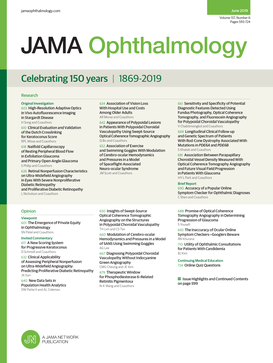
Ophthalmology is a surgical subspecialty within medicine that deals with the diagnosis and treatment of eye disorders. A former term is oculism.

Near-sightedness, also known as myopia and short-sightedness, is an eye disease where light from distant objects focuses in front of, instead of on, the retina. As a result, distant objects appear blurry while close objects appear normal. Other symptoms may include headaches and eye strain. Severe near-sightedness is associated with an increased risk of macular degeneration, retinal detachment, cataracts, and glaucoma.

A cataract is a cloudy area in the lens of the eye that leads to a decrease in vision of the eye. Cataracts often develop slowly and can affect one or both eyes. Symptoms may include faded colours, blurry or double vision, halos around light, trouble with bright lights, and difficulty seeing at night. This may result in trouble driving, reading, or recognizing faces. Poor vision caused by cataracts may also result in an increased risk of falling and depression. Cataracts cause 51% of all cases of blindness and 33% of visual impairment worldwide.

LASIK or Lasik, commonly referred to as laser eye surgery or laser vision correction, is a type of refractive surgery for the correction of myopia, hyperopia, and an actual cure for astigmatism, since it is in the cornea. LASIK surgery is performed by an ophthalmologist who uses a laser or microkeratome to reshape the eye's cornea in order to improve visual acuity.
Photophobia is a medical symptom of abnormal intolerance to visual perception of light. As a medical symptom, photophobia is not a morbid fear or phobia, but an experience of discomfort or pain to the eyes due to light exposure or by presence of actual physical sensitivity of the eyes, though the term is sometimes additionally applied to abnormal or irrational fear of light, such as heliophobia. The term photophobia comes from the Greek φῶς (phōs), meaning "light", and φόβος (phóbos), meaning "fear".

Strabismus is a vision disorder in which the eyes do not properly align with each other when looking at an object. The eye that is pointed at an object can alternate. The condition may be present occasionally or constantly. If present during a large part of childhood, it may result in amblyopia, or lazy eyes, and loss of depth perception. If onset is during adulthood, it is more likely to result in double vision.
Anterior ischemic optic neuropathy (AION) is a medical condition involving loss of vision caused by damage to the optic nerve as a result of insufficient blood supply (ischemia). This form of ischemic optic neuropathy is generally categorized as two types: arteritic AION, in which the loss of vision is the result of an inflammatory disease of arteries in the head called temporal arteritis, and non-arteritic AION, which is due to non-inflammatory disease of small blood vessels.
Vision therapy (VT), or behavioral optometry, is an umbrella term for alternative medicine treatments using eye exercises, based around the pseudoscientific claim that vision problems are the true underlying cause of learning difficulties, particularly in children. Vision therapy has not been shown to be effective using scientific studies, except for helping with convergence insufficiency. Most claims—for example that the therapy can address neurological, educational, and spatial difficulties—lack supporting evidence. Neither the American Academy of Pediatrics nor the American Academy of Ophthalmology support the use of vision therapy.

JAMA Ophthalmology is a monthly peer-reviewed medical journal covering all aspects of ophthalmology. The editor-in-chief is Neil M. Bressler. It is published by the American Medical Association, with which it has been affiliated since 1929.

Patricia Era Bath was an American ophthalmologist and humanitarian. She became the first female member of the Jules Stein Eye Institute, the first woman to lead a post-graduate training program in ophthalmology, and the first woman elected to the honorary staff of the UCLA Medical Center. Bath was the first African-American to serve as a resident in ophthalmology at New York University. She was also the first African-American woman to serve on staff as a surgeon at the UCLA Medical Center. Bath was the first African-American woman doctor to receive a patent for a medical purpose. A holder of five patents, she founded the non-profit American Institute for the Prevention of Blindness in Washington, D.C.

The British Journal of Ophthalmology is a peer-reviewed medical journal covering all aspects of ophthalmology. The journal was established in 1917 by the amalgamation of the Royal London (Moorfields) Ophthalmic Hospital Reports with the Ophthalmoscope and the Ophthalmic Record. The journal was edited for several years by Stewart Duke-Elder. Currently, Keith Barton, James Chodosh, and Jost Jonasand are editors-in-chief.

Current Eye Research is a medical journal covering all areas of ophthalmology. Areas covered include: clinical research, anatomy, physiology, biophysics, biochemistry, pharmacology, developmental biology, microbiology, and immunology
American Journal of Ophthalmology is a monthly peer-reviewed medical journal covering ophthalmology. It was established in 1884 and is published by Elsevier. The editor-in-chief is Richard K. Parrish II.
Jeewan Singh Titiyal is an Indian ophthalmologist, credited with the first live cornea transplant surgery by an Indian doctor. He was honoured by the Government of India, in 2014, by bestowing on him the Padma Shri, the fourth highest civilian award, for his services to the field of medicine.

Yog Raj Sharma is an Indian ophthalmologist and ex-chief of Dr. Rajendra Prasad Centre for Ophthalmic Sciences of the All India Institute of Medical Sciences (AIIMS), New Delhi, the apex body of the National Programme for the Control of Blindness, a Government of India initiative to reduce the prevalence of blindness in India. He is the Chairman of the Task Force on Prevention and Control of Diabetic Retinopathy Group and the Co-Chairman of the National Task Force on Prevention of Blindness from Retinopathy of Prematurity under the Ministry of Health and Family Welfare of the Government of India. An advisor to the Ministry of Health and Family Welfare, India. Sharma was honored by the Government of India in 2015 with Padma Shri, the fourth highest Indian civilian award. In 2005, Yog Raj Sharma's published article on "Pars plana vitrectomy vs scleral buckling in rhegmatogenous retinal detachment" in Acta Ophthalmologica Scandinavica and in November 2021, American society of retina specialists cited it as top 100 publications on retinal detachment management in the last ~121 years. Of these top hundred publications, only nineteen countries contributed, three of the contributing countries were Asian and from India this study was the sole contribution. Dr Sharma called it 'the singular biggest achievement of his career" in an article published in Daily Excelsior, Jammu in December 2021.
Santosh Gajanan Honavar is an Indian ophthalmologist and is currently the editor of the Indian Journal of Ophthalmology and Indian Journal of Ophthalmology - Case Reports, the official journals of the All India Ophthalmological Society; Director, Medical Services ; Director, Department of Ocular Oncology and Oculoplasty at Centre for Sight, Hyderabad; and Director, National Retinoblastoma Foundation.
The Journal of Pediatric Ophthalmology and Strabismus is a bimonthly peer-reviewed publication for pediatric ophthalmologists. The journal publishes articles regarding eye disorders in pediatric individuals and the treatment of strabismus in all age groups.
Mohammad Javed Ali is an Ophthalmic Plastics Surgeon, Dacryologist, and Clinician-scientist. He heads the Govindram Seksaria Institute of Dacryology, L. V. Prasad Eye Institute, Hyderabad and specializes in the science of tear ducts. Prof. Ali is also the Alumni chair of Ophthalmology at the L.V. Prasad Eye Institute and the current Editor-in-Chief of Seminars in Ophthalmology', Associate Editor of several major journals, including 'The Ocular Surface', 'Ophthalmic Research', 'Survey of Ophthalmology', and 'Current Eye Research'. He holds several international professorships, including the Hong-Leong Professor at University of Singapore, Professor of Anatomy and Ophthalmology at the Friedrich Alexander University, Nuremberg, Germany, Professor, Wojskowy Instytut Medyczny at Warsaw, Honorary Professor at Krasonv Research Institute of Eye Diseases, Moscow, Adjunct Professor at University of Rochester, and Professor of Ophthalmology at Shanghai Jin Tao University, China.
Progress in Retinal and Eye Research is a bimonthly peer-reviewed medical journal covering all aspects of ophthalmology. It was established in 1994 by Elsevier.










